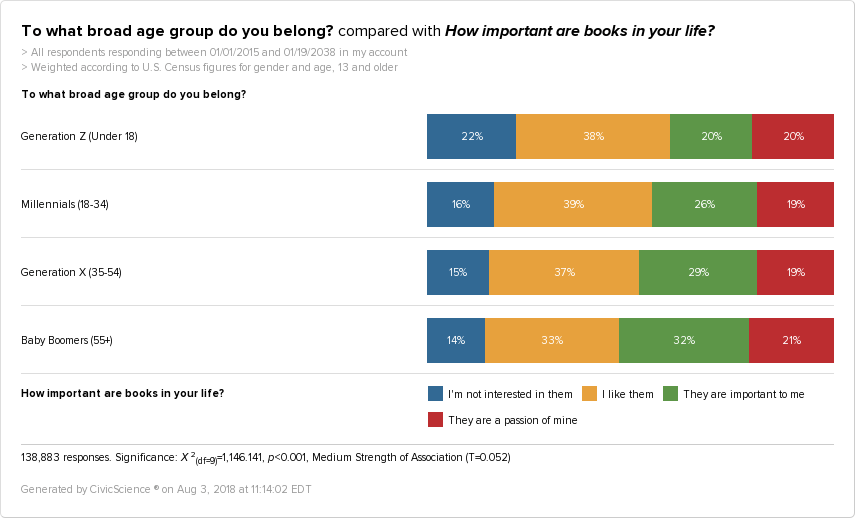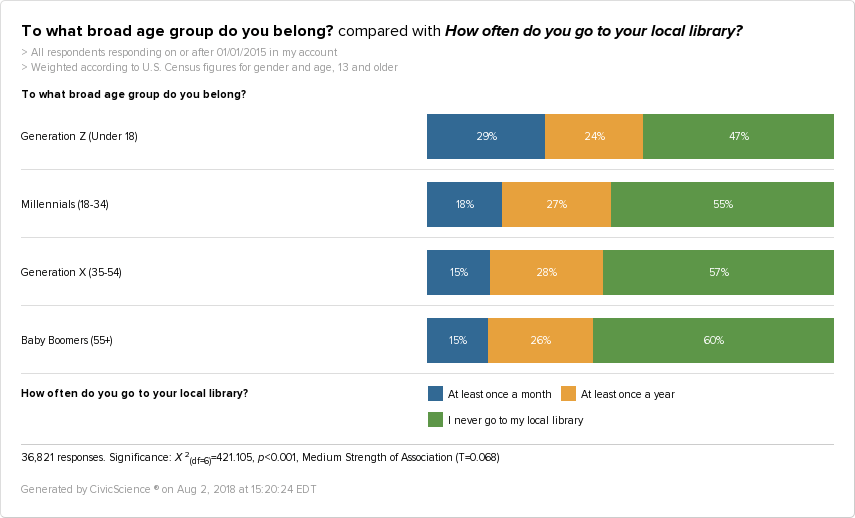Every day, another report emerges. Young people are killing napkins, beer, the housing market. They’re disconnected on devices; they’re staying at home.
CivicScience can track all types of trends across industries, so it’s easy to ask the question, what are young people saving?
Libraries.
After a dust-up in Forbes a few weeks ago in where an op-ed suggesting Amazon replace public libraries was apologized for, and subsequently deleted, CivicScience took a look at a question on library attendance that’s been asked to over 37,000 Americans since 2015.
57%, the majority of Americans, never visit their local library, and only 17% go at least once a month. But, breaking the data down by generation tells a very different story.
Gen Zers are nearly twice more likely than any age group to go to the library at least once a month. 18% of Millennials use the library at least once a month, and outpace Gen Zers on annual attendance.
What’s drawing these populations to libraries? Based on CivicScience data, books alone aren’t bringing them in.

With no major variations, both Gen Z and Millennials are at most lukewarm on books compared to older populations. Most public libraries offer more than just reading material, and based on insights of frequent library attendants; it seems they could taking advantage of the many tools libraries offer.
Based on the age trends, it’s no surprise people who go to the library more than once a month are interested in technology. They exhibit early adopter behaviors, including interest in VR technology, augmented reality, and smartwatches. If you haven’t been to a local library recently, you might be surprised to learn the amount of technology lending that takes place in libraries.
From VR to 3D printing, public libraries across the country have aggressively sought to integrate technology services into their spaces. Given the interest in tech trends, it’s not a jump to assume these features draw a younger, tech-focused crowd to the library. Especially when you consider the pocketbooks of this group–they’re more likely to be unemployed and live with their parents. Libraries offer the ability to try high-end tech for free; it’s no wonder Gen Z and Millennials are flocking to the spaces.
And with early adopter behaviors often comes social media usage. People who go to the library at least once a month or more are most influenced by social media in their purchasing and lifestyle choices. Whether they’re using public library computers, or just jumping on reliable WiFi, the library is a free space where young people can get online easily.
Public libraries might not look the same as they once did, but their services are still helping to raise responsible young people. Visitors that frequent the library at least once a month are twice as likely to volunteer at least once a week, donate to charities, exercise regularly, and adjust their lifestyles to help the environment.
So while some suggest Amazon in lieu of libraries, it’s unlikely these spaces are going anywhere. Based on the behaviors of the populations using them the most, they’ve secured a future of volunteers and donors.










